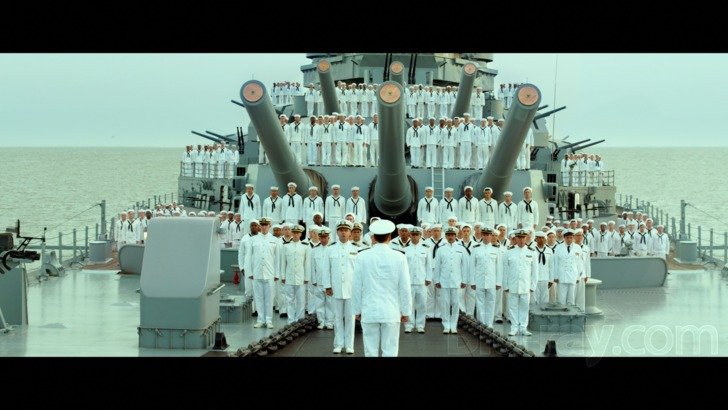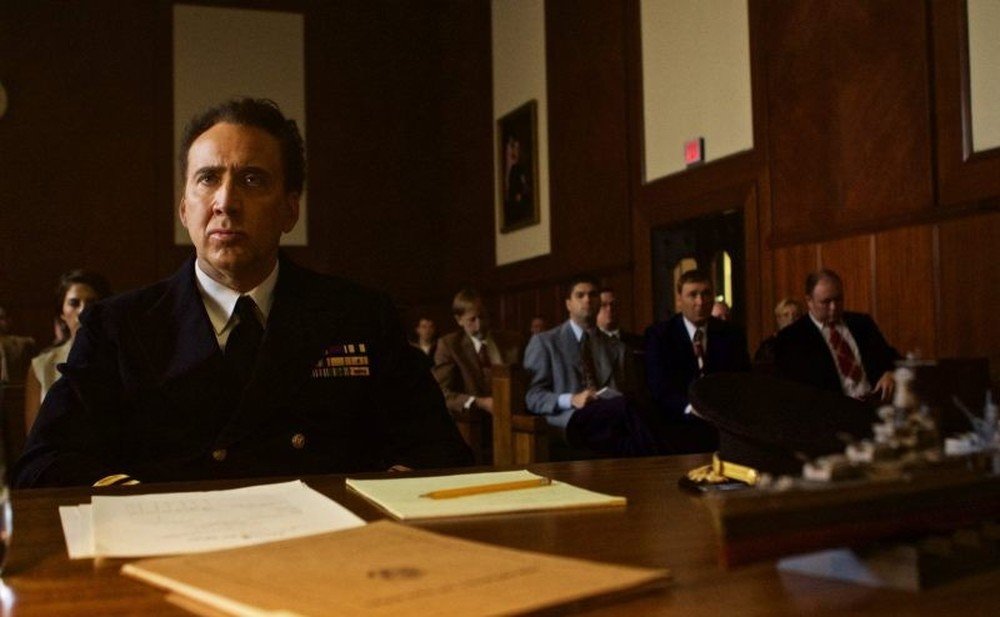Nicolas Cage Tangles With Cartoon Sharks in USS Indianapolis: Men of Courage
The Travolta/Cage Project is an ambitious, years-long multi-media exploration of the fascinating, overlapping legacies of Face/Off stars John Travolta and Nicolas Cage with two components: this online column exploring the actor’s complete filmographies in chronological order and the Travolta/Cage podcast, where Clint Worthington, myself and a series of fascinating guests discuss the movies I write about here.
Read previous entries in the column here, listen to the podcast here, pledge to the Travolta/Cage Patreon at this blessed web address and finally follow us on Twitter at https://twitter.com/travoltacage
I was not at all excited about watching the poorly received 2016 flop USS Indianapolis: Men of Courage until I discovered that it wasn’t just a generic-looking World War II movie: it was a shark movie.
More specifically USS Indianapolis is about the legendary military tragedy where hundreds of American soldiers died horrible deaths due to hunger, dehydration and shark attacks after Japanese torpedos sunk the titular ship.
War movies bore me for the most part but watching reasonably priced character actors like Tom Sizemore get cut in half by the razor-sharp teeth of nature’s perfect killing machine sounded like a hoot and a half.
That’s the thing about sharks. We’re terrified of them. They’re an animal seemingly created specifically to be the bad guys in horror movies. They have the cold, dead eyes of killers and move with relentless, unstoppable speed, grace and determination.
Yet there’s also something terribly appealing about sharks as well. The power that makes them terrifying also makes them figures of wish fulfillment. Who wouldn’t want to have that power, speed and ferocity?
There’s a reason Shark Week is generally considered the most important week of any given year and why we call people who are very good at what they do but also unethical and ruthless sharks.
Sharks are figures of terror. They’re figures of kitsch. They’re cult figures.
Watching USS Indianapolis the sociopathic nihilist in me rooted for the sharks to win and eat everyone in excessively violent, extremely satisfying ways. I wanted these soldiers to come up against a veritable Sharknado of watery terror.
The devil on my shoulder spent the film delighting in the prospect of mass death by shark teeth. The angel on my shoulder, however, wanted good, heroic soldiers to not have their heads ripped off in one chomp by blood-crazed underwater killers.
The story of the USS Indianapolis has already been brought to the big screen in an iconic fashion not in a major motion picture but rather in a monologue from a popular choice for the greatest horror film of all time: Jaws.
The sinking of the USS Indianapolis and the shark-fueled carnage that ensued is the subject of Quint’s famous speech about the cold, dead eyes of sharks from Steven Spielberg’s Jaws.
The USS Indianapolis has consequently already achieved cinematic immortality as the subject of one of the most beloved scenes in one of the greatest and most influential movies ever made.
Mario Van Peebles’ bloated mediocrity is a footnote by comparison.
Van Peebles famously tangled with a vengeance-crazed shark in 1987’s Jaws: The Revenge. Van Peebles’ participation in the notorious stinker was clearly mercenary in nature. This time, it’s personal. Or not!
Nicolas Cage stars as Captain Charles McVay III. He’s a veteran officer who is given the crucial job of delivering parts for the atomic bomb that was dropped on Hiroshima to the island of Tinian.
Cage’s officer succeeds in delivering the components for the bomb but on the way back is stuck by a pair of Japanese torpedos that sink the ship in a matter of minutes.
Name a more iconic duo!
Hundreds of soldiers died in the attack itself but others threw themselves overboard and tried to locate rafts in a desperate struggle for survival.
Things already look grim before sharks, nature’s executioners, entered the picture. Sharks generally don’t bother people unless they’re bleeding. Unfortunately for the soldiers you tend to bleed an awful lot when your vessel sinks after being hit by torpedos.
Two soldiers have something other than drowning, starvation or having a shark bite off their head to worry about. In the grand tradition of cheesy war movies, USS Indianapolis includes a love triangle between two soldiers and the woman they both love back home.
The idea is to highlight the humanity of the soldiers who died agonizing, watery deaths, to allow us to see them as ordinary people with hopes and dreams and complicated romantic entanglements.
Yet within the scope of the film, this love triangle could not feel less essential or important. In this crazy world, with ravenous sharks on one side and the unthinkable devastation of the Hiroshima and Nagasaki bombings on the other, the problems of three little people don’t amount to a hill of beans.
As a veteran of the Jaws franchise, most notably Jaws: The Revenge, Van Peebles should know how important verisimilitude is to shark movies. That, alas, is one of the many areas where the film comes short.
The sharks never have any physicality. They lack the stubborn craftsmanship of practical effects. The sharks here are never anything other than a cartoon. Cartoon sharks can’t kill you. They can’t even hurt you. You know why? Because they’re cartoons.
You know who else was a cartoon as well as a shark? Jabberjaw. A poorly animated shark who plays drums and talks like Curly Howard isn’t scary and neither are the CGI sharks of USS Indianapolis: Men of Courage.
I suspect that I would have liked USS Indianapolis: Men of Courage more if it had leaned into its grisly elements. This eminently forgettable exploration of a uniquely horrifying and deadly disaster would have been more distinctive and engaging as a war-horror hybrid rather than a conventional war movie that just happens to feature sharks biting off people’s heads.
If nothing else USS Indianapolis gives Cage a juicy role that plays into two core components of his persona. Playing a true leader of men during a time of extreme crisis allows Cage to embrace the supportive Father and overgrown Boy Scout elements of his multi-faceted persona.
Cage plays Captain Charles McVay III as a profoundly good man in quite possibly the worst situation in human history. Things are so dire for the weary survivors floating helplessly in the water that it’s easy to see how the living could come to envy the dead.
Astonishingly, a hopelessly cruel and sadistic world had further painful punishment for Captain McVay. The military needed a scapegoat to take the blame for the sinking of the USS Indianapolis so it chose McVay.
The war hero became the only Captain court-martialed for the loss of a ship during World War II. As the maraschino cherry on the triple decker sundae of tragedy that was the sinking of the USS Indianapolis, McVay later committed suicide.
The story of the USS Indianapolis is one of heartbreak and horror, duty and disgrace yet Van Peebles has made a hokey, conventional war movie strangely short on passion.
The film’s script is so old fashioned that it feels like it could have been written any time between 1945 and the present. The only particularly contemporary angle are the cartoon sharks.
USS Indianapolis fundamentally does not work yet I found myself getting choked up at the end due to the power and conviction of Cage’s performance and the Job-like tragedy of his character.
As is often the case USS Indianapolis is nothing special but Cage’s performance sure is.
Failure, Fiasco or Secret Success: Failure
Check out The Joy of Trash: Flaming Garbage Fire Extended Edition at https://www.nathanrabin.com/shop and get a free, signed "Weird Al” Yankovic-themed coloring book for free! Just 18.75, shipping and taxes included! Or, for just 25 dollars, you can get a hardcover “Joy of Positivity 2: The New Batch” edition signed (by Felipe and myself) and numbered (to 50) copy with a hand-written recommendation from me within its pages. It’s truly a one-of-a-kind collectible!
I’ve also written multiple versions of my many books about “Weird Al” Yankovic that you can buy here: https://www.nathanrabin.com/shop
Or you can buy The Joy of Trash from Amazon at https://www.amazon.com/Joy-Trash-Nathan-Definitive-Everything/dp/B09NR9NTB4/ref=tmm_pap_swatch_0?_encoding=UTF8&qid=&sr= but why would you want to do that?
Check out my new Substack at https://nathanrabin.substack.com/
And we would love it if you would pledge to the site’s Patreon as well. https://www.patreon.com/nathanrabinshappyplace









